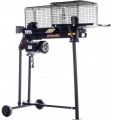Splitting speed
The time it takes for the cleaver/knife to move from the top end position to the bottom end position. The splitting speed is measured in centimeters per second (cm/s). The average wood splitter has a speed of 4 cm / s. This indicator is influenced by both the drive power and the piston stroke height. In turn, the splitting speed itself affects the performance of the wood splitter — the higher it is, the faster the device will cope with the work.
Oil volume (hydraulic system)
The total amount of oil that can fit into the hydraulic system of the respective log splitter (see "Type"). This parameter allows you to estimate how much oil is required for one refueling or refilling of the unit.
Max. power
Wood splitter motor power in watts. The designation in watts is used for all types of engines, which allows you to compare units with different types of motors.
A powerful motor is needed above all in order to provide a high splitting force (see above). However, when choosing, it is worth focus not so much on power, but on the force stated in the characteristics and the length / thickness of the logs. In addition, in the case of electric motors (see "Motor type"), the power directly determines the energy consumption, which is important in some situations (when running from a generator, with weak wiring, etc.)
Stand
The presence of high legs
(stands) for a horizontal wood splitter will allow you to use it when it is installed immediately on the ground, floor. There is no need to make an additional elevation in the form of a table, a workbench for more convenient feeding and chopping of small logs. But compact models of
horizontal wood splitters without a stand are of two types. The first includes ground models for chopping powerful logs, which it makes no sense to raise to a height. The second type provides wood splitters for installation on a hill, which, due to the lack of a stand, must be provided in advance. In both cases, the absence of a stand (high legs) makes the model more compact and more mobile.
Country of origin
Country of origin of the brand under which the log splitter is presented on the market. This country does not necessarily coincide with the place of actual production — on the contrary, it is not uncommon for individual parts to be produced in one state, assembled in another, and the brand generally comes from a third.
Also note that the country of origin itself does not affect the quality of the goods — a lot depends on the specific brand and even specific models. So it makes sense to pay attention to this information mainly in those cases when you fundamentally want (or do not want) to support a manufacturer from a certain country. Among the countries producing wood splitters are:
Austria,
Belarus,
Germany,
Denmark,
China,
Poland,
Russia,
USA,
Slovenia,
Ukraine,
Czech Republic,
Japan.

